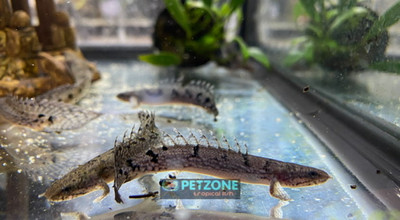Delhezi Bichir
Posted by Max Gandara on on 9th Jul 2025
Delhezi Bichir: The Striped Sentinel of the Congo
(Polypterus delhezi)
Bold, ancient, and unmistakably unique—the Delhezi Bichir, also known as the Armored Bichir or Barred Bichir, is a living fossil that adds prehistoric flair to any large freshwater aquarium. With its striking dark vertical bands, spiny dorsal finlets, and thick armored body, this nocturnal predator from the Congo River Basin is a favorite among monster fish keepers and oddball enthusiasts alike.
Quick Facts
-
Common Name: Delhezi Bichir, Barred Bichir
-
Scientific Name: Polypterus delhezi
-
Origin: Congo River Basin, Central Africa
-
Adult Size: Up to 14–18 inches
-
Temperament: Semi-aggressive, solitary predator
-
Lifespan: 10–15+ years in captivity
Distinctive Appearance
The Delhezi Bichir is easily recognizable by its thick, armored body covered in gray-green scales, punctuated with bold vertical bands or "bars." Its spiny dorsal finlets, wide head, and upturned eyes give it a primal, dinosaur-like aesthetic. This combination of coloration and body shape allows it to blend into riverbeds and driftwood in the wild—ideal for ambushing prey.
Behavior and Personality
Delhezi Bichirs are slow-moving, bottom-dwelling fish that display calm but alert behavior. They're mostly nocturnal, often becoming more active after lights go out. While not aggressive toward similarly sized tankmates, they are opportunistic feeders and will eat anything small enough to fit in their mouths.
They are also excellent escape artists, so tight-fitting lids are non-negotiable.
Ideal Tank Setup
? Tank Size:
Minimum 75 gallons for a single adult. Provide ample floor space and horizontal swimming room.
? Water Parameters:
-
Temperature: 75–82°F
-
pH: 6.5–7.5
-
Hardness: 5–20 dGH
-
Keep water clean with strong filtration and moderate flow.
? Décor Recommendations:
-
Sandy or fine gravel substrate
-
Driftwood, rocks, and caves for hiding
-
Dim lighting or floating plants to mimic natural conditions
-
Secure lid (Bichirs can breathe atmospheric air and may try to explore!)
Diet & Feeding
Delhezi Bichirs are carnivorous and require a protein-rich diet. In captivity, they adapt well to a variety of foods:
-
Frozen shrimp, silversides, bloodworms
-
Live foods like earthworms or feeder fish (caution: risk of parasites)
-
High-quality sinking carnivore pellets
-
Chopped fish or mussel meat
Feed 3–4 times per week in portions they can consume in a few minutes. Remove leftovers to maintain water quality.
Tankmates
Compatible with other large, non-aggressive species, such as:
-
Other Bichirs (similar size)
-
Large catfish (e.g., Synodontis)
-
Arowanas, larger cichlids, Datnoids
-
Rope Fish, Knife Fish
Avoid small fish like tetras or guppies—they will quickly become snacks.
Breeding
Breeding in captivity is rare and challenging. Delhezi Bichirs are egg scatterers and require seasonal conditioning with slight water changes to mimic natural cycles. Males have broader anal fins and are typically slimmer than females. Specialized setups with leaf litter and fine plants may encourage breeding behavior.
Final Thoughts
If you're drawn to ancient, armored fish with bold personalities, the Delhezi Bichir is a top-tier addition to your aquarium. Hardy, beautiful, and endlessly fascinating, this prehistoric predator brings a raw, wild energy to the tank.
Just be sure you’re ready for the commitment—they’re long-lived, need space, and require responsible feeding and housing. But for the right aquarist, Delhezi Bichirs are an unforgettable aquatic companion.

